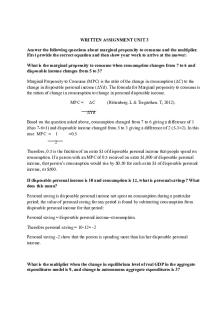Written Assignment unit 3 PDF

| Title | Written Assignment unit 3 |
|---|---|
| Author | Liz Be |
| Course | Macroeconomics |
| Institution | University of the People |
| Pages | 2 |
| File Size | 80.8 KB |
| File Type | |
| Total Downloads | 9 |
| Total Views | 179 |
Summary
Download Written Assignment unit 3 PDF
Description
WRITTEN ASSIGNMENT UNIT 3 Answer the following questions about marginal propensity to consume and the multiplier. First provide the correct equation and then show your work to arrive at the answer: What is the marginal propensity to consume when consumption changes from 7 to 6 and disposable income changes from 5 to 3? Marginal Propensity to Consume (MPC) is the ratio of the change in consumption (ΔC) to the change in disposable personal income (ΔYd). The formula for Marginal propensity to consume is the ration of change in consumption to change in personal disposable income. MPC =
ΔC
(Rittenberg. L & Tregarthen. T, 2012).
ΔYd Based on the question asked above, consumption changed from 7 to 6 giving a difference of 1 (thus 7-6=1) and disposable income changed from 5 to 3 giving a difference of 2 (5-3=2). In this case MPC = 1 =0.5 2 Therefore, 0.5 is the fraction of an extra $1 of disposable personal income that people spend on consumption. If a person with an MPC of 0.5 received an extra $1,000 of disposable personal income, that person’s consumption would rise by $0.50 for each extra $1 of disposable personal income, or $500. If disposable personal income is 10 and consumption is 12, what is personal savings? What does this mean? Personal saving is disposable personal income not spent on consumption during a particular period; the value of personal saving for any period is found by subtracting consumption from disposable personal income for that period: Personal saving = disposable personal income−consumption. Therefore personal saving = 10-12= -2 Personal saving -2 show that the person is spending more than his/her disposable personal income.
What is the multiplier when the change in equilibrium level of real GDP in the aggregate expenditures model is 9, and change in autonomous aggregate expenditures is 3?
Multiplier =Δ (real GDP demanded at each price level)
( Rittenberg. L & Tregarthen. T, 2012).
Initial Δ (component of AD) Which is
9
=3
3 What is the multiplier when the marginal propensity to save is 1/3? Multiplier =
1
which is 1/0.33 = 3.03
MPC What would happen to the marginal propensity to save when a tax cut was enacted causing the multiplier to change to 5? 1/5 Reference Rittenberg. L & Tregarthen. T, 2012). Macroeconomics Principles v.2.0 textbook. Retrieved from https://my.uopeople.edu/pluginfile.php/136135/mod_resource/content/1/TEXT %20macroeconomics-principles-v2.0.pdf...
Similar Free PDFs

Written Assignment Unit 3
- 4 Pages

Written Assignment unit 3
- 2 Pages

Written Assignment Unit 3
- 2 Pages

Written Assignment Unit 2
- 3 Pages

Written Assignment Unit 7
- 3 Pages

Written Assignment UNIT 5
- 6 Pages

Written Assignment Unit 2
- 5 Pages

Written Assignment Unit 2
- 1 Pages

Written Assignment Unit 6
- 8 Pages

Written assignment unit 4
- 5 Pages

Written assignment unit 4
- 4 Pages

Written Assignment Unit 6
- 4 Pages

Written Assignment unit 5
- 5 Pages

Unit 4 Written Assignment
- 4 Pages
Popular Institutions
- Tinajero National High School - Annex
- Politeknik Caltex Riau
- Yokohama City University
- SGT University
- University of Al-Qadisiyah
- Divine Word College of Vigan
- Techniek College Rotterdam
- Universidade de Santiago
- Universiti Teknologi MARA Cawangan Johor Kampus Pasir Gudang
- Poltekkes Kemenkes Yogyakarta
- Baguio City National High School
- Colegio san marcos
- preparatoria uno
- Centro de Bachillerato Tecnológico Industrial y de Servicios No. 107
- Dalian Maritime University
- Quang Trung Secondary School
- Colegio Tecnológico en Informática
- Corporación Regional de Educación Superior
- Grupo CEDVA
- Dar Al Uloom University
- Centro de Estudios Preuniversitarios de la Universidad Nacional de Ingeniería
- 上智大学
- Aakash International School, Nuna Majara
- San Felipe Neri Catholic School
- Kang Chiao International School - New Taipei City
- Misamis Occidental National High School
- Institución Educativa Escuela Normal Juan Ladrilleros
- Kolehiyo ng Pantukan
- Batanes State College
- Instituto Continental
- Sekolah Menengah Kejuruan Kesehatan Kaltara (Tarakan)
- Colegio de La Inmaculada Concepcion - Cebu

